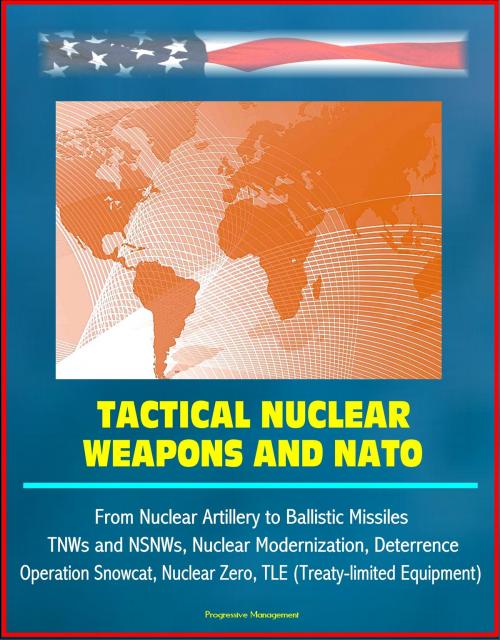Tactical Nuclear Weapons and NATO - From Nuclear Artillery to Ballistic Missiles, TNWs and NSNWs, Nuclear Modernization, Deterrence, Operation Snowcat, Nuclear Zero, TLE (Treaty-limited Equipment)
Nonfiction, History, Military, Nuclear Warfare| Author: | Progressive Management | ISBN: | 9781301465453 |
| Publisher: | Progressive Management | Publication: | March 13, 2013 |
| Imprint: | Smashwords Edition | Language: | English |
| Author: | Progressive Management |
| ISBN: | 9781301465453 |
| Publisher: | Progressive Management |
| Publication: | March 13, 2013 |
| Imprint: | Smashwords Edition |
| Language: | English |
This comprehensive history of the role of tactical nuclear weapons in Europe, and their continued presence on the continent, provides a fascinating overview of one of the Cold War's most important facets. The preface states:
the history of the Cold War is a nuclear history, centered around each side's efforts to convince the other of a readiness for a war that neither wanted. Tactical nuclear weapons were crucial to this effort, because they were the link between conventional war in Europe and a central nuclear exchange between the superpowers. The Soviets were unlikely to believe that the President would risk New York and Chicago for the people of Europe, which was the central premise of the short-lived and poorly conceived strategy of "Massive Retaliation." A threat to leap to Armageddon because of a scuffle between the Soviets and the West Germans was on its face incredible, to Moscow as much as to us. Tactical nuclear weapons provided the solution. The West abandoned any hope of matching Warsaw Pact conventional forces man for man or tank for tank, and instead placed nuclear weapons in Europe, many of them directly in front of the assumed axes of Soviet advance where they would assuredly be overrun or employed. This warned the Soviets, in effect, that if Europe were invaded, the choice to use nuclear arms would be forced upon NATO by the successes of the Red Army. Western commanders, faced with imminent defeat, would fire their tactical arms in desperation at advancing Soviet units. This was a terrifying but effective strategy. As we now know, the Soviet High Command wrestled with this dilemma, since taking a Europe in ashes defeated the whole point of invasion in the first place. All of the options led to the same dead end of escalation, strategic retaliation, and catastrophe. Combat along the Central Front probably would have decayed into a nuclear war sooner rather than later, with unimaginable consequences. Today, the Central Front is gone.
Tactical Nuclear Weapons and NATO: An Introductory Reminiscence * PART I. THE HISTORICAL CONTEXT OF TACTICAL NUCLEAR WEAPONS * 1. The Historical Context * 2. Tactical Nuclear Weapons in NATO and Beyond: A Historical and Thematic Examination * 3. U.S. Nuclear Weapons Policy and Policymaking: The Asian Experience * PART II. RUSSIAN PERSPECTIVES ON TACTICAL NUCLEAR WEAPONS * 4. Russian Perspectives on Tactical Nuclear Weapons * 5. Russian Doctrine on Tactical Nuclear Weapons: Contexts, Prisms, and Connections * 6. Aspects of the Current Russian Perspective on Tactical Nuclear Weapons * 7. Influences on Russian Policy and Possibilities for Reduction in Non-Strategic Nuclear Weapons * 8. Russian Perspectives on Non-Strategic Nuclear Weapons * 9. Introduction of European Policies and Opinions Relating to Tactical Nuclear Weapons * 10. The Role and Place of Tactical Nuclear Weapons — A NATO Perspective * 11. European and German Perspectives * 12. European Perspectives * 13. Europe, NATO's Tactical Nuclear Conundrum, and Public Debate: Be Careful What You Wish For * PART IV. AMERICAN PERSPECTIVES * 14. American Perspectives on Tactical Nuclear Weapons * 15. Role of Non-Strategic Nuclear Weapons: An American Perspective * 16. NATO's Nuclear Debate: The Broader Strategic Context * 17. Role of Nuclear Weapons in NATO's Deterrence and Defense Posture Review: Prospects for Change * PART V. ARMS CONTROL AS AN OPTION * 18. Tactical Nuclear Weapons and NATO: Arms Control as an Option * 19. Arms Control Options for Non-Strategic Nuclear Weapons * 20. Tactical Nuclear Weapons and NATO: A Conventional Arms Control Perspective * 21. Arms Control after START * 22. The Conventional and Nuclear Nexus in Europe * PART VI. CONCLUSION * 23. Summing Up and Issues for the Future
This comprehensive history of the role of tactical nuclear weapons in Europe, and their continued presence on the continent, provides a fascinating overview of one of the Cold War's most important facets. The preface states:
the history of the Cold War is a nuclear history, centered around each side's efforts to convince the other of a readiness for a war that neither wanted. Tactical nuclear weapons were crucial to this effort, because they were the link between conventional war in Europe and a central nuclear exchange between the superpowers. The Soviets were unlikely to believe that the President would risk New York and Chicago for the people of Europe, which was the central premise of the short-lived and poorly conceived strategy of "Massive Retaliation." A threat to leap to Armageddon because of a scuffle between the Soviets and the West Germans was on its face incredible, to Moscow as much as to us. Tactical nuclear weapons provided the solution. The West abandoned any hope of matching Warsaw Pact conventional forces man for man or tank for tank, and instead placed nuclear weapons in Europe, many of them directly in front of the assumed axes of Soviet advance where they would assuredly be overrun or employed. This warned the Soviets, in effect, that if Europe were invaded, the choice to use nuclear arms would be forced upon NATO by the successes of the Red Army. Western commanders, faced with imminent defeat, would fire their tactical arms in desperation at advancing Soviet units. This was a terrifying but effective strategy. As we now know, the Soviet High Command wrestled with this dilemma, since taking a Europe in ashes defeated the whole point of invasion in the first place. All of the options led to the same dead end of escalation, strategic retaliation, and catastrophe. Combat along the Central Front probably would have decayed into a nuclear war sooner rather than later, with unimaginable consequences. Today, the Central Front is gone.
Tactical Nuclear Weapons and NATO: An Introductory Reminiscence * PART I. THE HISTORICAL CONTEXT OF TACTICAL NUCLEAR WEAPONS * 1. The Historical Context * 2. Tactical Nuclear Weapons in NATO and Beyond: A Historical and Thematic Examination * 3. U.S. Nuclear Weapons Policy and Policymaking: The Asian Experience * PART II. RUSSIAN PERSPECTIVES ON TACTICAL NUCLEAR WEAPONS * 4. Russian Perspectives on Tactical Nuclear Weapons * 5. Russian Doctrine on Tactical Nuclear Weapons: Contexts, Prisms, and Connections * 6. Aspects of the Current Russian Perspective on Tactical Nuclear Weapons * 7. Influences on Russian Policy and Possibilities for Reduction in Non-Strategic Nuclear Weapons * 8. Russian Perspectives on Non-Strategic Nuclear Weapons * 9. Introduction of European Policies and Opinions Relating to Tactical Nuclear Weapons * 10. The Role and Place of Tactical Nuclear Weapons — A NATO Perspective * 11. European and German Perspectives * 12. European Perspectives * 13. Europe, NATO's Tactical Nuclear Conundrum, and Public Debate: Be Careful What You Wish For * PART IV. AMERICAN PERSPECTIVES * 14. American Perspectives on Tactical Nuclear Weapons * 15. Role of Non-Strategic Nuclear Weapons: An American Perspective * 16. NATO's Nuclear Debate: The Broader Strategic Context * 17. Role of Nuclear Weapons in NATO's Deterrence and Defense Posture Review: Prospects for Change * PART V. ARMS CONTROL AS AN OPTION * 18. Tactical Nuclear Weapons and NATO: Arms Control as an Option * 19. Arms Control Options for Non-Strategic Nuclear Weapons * 20. Tactical Nuclear Weapons and NATO: A Conventional Arms Control Perspective * 21. Arms Control after START * 22. The Conventional and Nuclear Nexus in Europe * PART VI. CONCLUSION * 23. Summing Up and Issues for the Future















